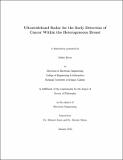| dc.contributor.advisor | Jones, Edward | |
| dc.contributor.advisor | Glavin, Martin | |
| dc.contributor.author | Byrne, Dallan | |
| dc.date.accessioned | 2012-11-07T12:50:25Z | |
| dc.date.available | 2012-11-07T12:50:25Z | |
| dc.date.issued | 2012-01-18 | |
| dc.identifier.uri | http://hdl.handle.net/10379/3035 | |
| dc.description.abstract | Ultrawideband (UWB) microwave imaging is an emerging breast screening modality
based on the electromagnetic reflections generated by the dielectric contrast between
soft tissue types within the breast at microwave frequencies, most notably between
malignant and fatty tissue. However, the breast can contain significant amounts of
fibroglandular or fibroconnective tissues, which reduce the dielectric contrast between
healthy and cancerous tissue and limits the effectiveness of UWB imaging algorithms.
This dissertation focuses on UWB scanning techniques to detect cancer, with a par-
ticular focus on the dielectrically heterogeneous breast. The work can be viewed in
two parts: UWB breast cancer imaging and UWB breast cancer detection.
The first part focuses on UWB beamforming algorithms and their ability to image a tumour response when the breast contains significant levels of glandular tissue.
A number of Data Independent beamforming methods are compared using metrics,
where signal data are generated from 3D Finite-Difference Time-Domain (FDTD)
models adapted from MRI-derived phantoms. A novel extension of a Data Adap-
tive imaging algorithm is presented and is shown to significantly outperform existing
beamformers, particularly in a dielectrically heterogeneous breast. The application
of contrast agents with UWB imaging methods is shown to successfully image non-
palpable tumours when significant levels of fibroglandular tissue are present.
The second area of study focuses on using a Support Vector Machine (SVM) based
UWB cancer detection system to identify tumour backscatter within the received
UWB signal data. The algorithm is extended to process the temporal changes between
signals using an SVM and is shown to successfully detect non-palpable tumours when
fluctuations in glandular tissue density and cancerous growth can occur during the
time between scans. | en_US |
| dc.rights | Attribution-NonCommercial-NoDerivs 3.0 Ireland | |
| dc.rights.uri | https://creativecommons.org/licenses/by-nc-nd/3.0/ie/ | |
| dc.subject | Ultrawideband | en_US |
| dc.subject | Breast imaging | en_US |
| dc.subject | Beamforming | en_US |
| dc.subject | Electrical and Electronic Engineering | en_US |
| dc.subject | Engineering and Informatics | en_US |
| dc.title | Ultrawideband Radar for the Early Detection of Cancer Within the Heterogeneous Breast | en_US |
| dc.type | Thesis | en_US |
| dc.contributor.funder | Ircset Enterprise Partnership Scheme | en_US |
| dc.contributor.funder | Hewlett Packard | en_US |
| dc.local.note | Ultrawideband (UWB) microwave imaging is an emerging breast screening modality
based on the electromagnetic reflections generated by the dielectric contrast between
soft tissue types within the breast at microwave frequencies, most notably between
malignant and fatty tissue. However, the breast can contain significant amounts of
fibroglandular or fibroconnective tissues, which reduce the dielectric contrast between
healthy and cancerous tissue and limits the effectiveness of UWB imaging algorithms.
This dissertation focuses on UWB scanning techniques to detect cancer, with a par-
ticular focus on the dielectrically heterogeneous breast. The work can be viewed in
two parts: UWB breast cancer imaging and UWB breast cancer detection.
The first part focuses on UWB beamforming algorithms and their ability to im-
age a tumour response when the breast contains significant levels of glandular tissue.
A number of Data Independent beamforming methods are compared using metrics,
where signal data are generated from 3D Finite-Difference Time-Domain (FDTD)
models adapted from MRI-derived phantoms. A novel extension of a Data Adap-
tive imaging algorithm is presented and is shown to significantly outperform existing
beamformers, particularly in a dielectrically heterogeneous breast. The application
of contrast agents with UWB imaging methods is shown to successfully image non-
palpable tumours when significant levels of fibroglandular tissue are present.
The second area of study focuses on using a Support Vector Machine (SVM) based
UWB cancer detection system to identify tumour backscatter within the received
UWB signal data. The algorithm is extended to process the temporal changes between
signals using an SVM and is shown to successfully detect non-palpable tumours when
fluctuations in glandular tissue density and cancerous growth can occur during the
time between scans. | en_US |
| dc.local.final | Yes | en_US |
| nui.item.downloads | 483 | |


